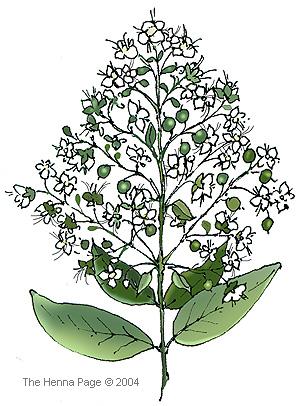Catherine Cartwright-Jones © 2004
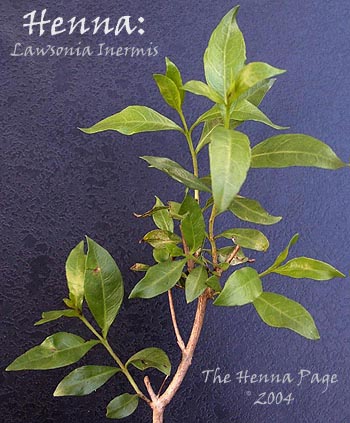
Henna is Lawsonia Inermis, family Lythraceae
Articles on the Botany and Chemistry of Henna:
|
|
Henna is a small tree or large shrub, growing to six
meters
high. It has
lateral branches with leaves that grow in pairs, two to four
centimeters. long.
 Henna is a juvenile plant for the
first two years. The leaves do not
have high lawsone content, and the branches do not have thorns. In
mature
plants, thorns develop at the leaf buds during dormant phases. When
hungry animals come to nibble the
new leaves, they prick their tongues on the thorns and go look for
another plant to eat.
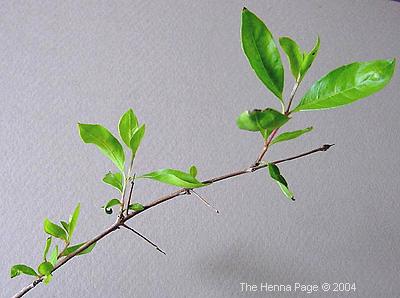 Henna leaves have a red-orange dye, lawsone, and the highest dye concentration is in the petiole (the central vein). Young leaves have the highest petiole dye content. Older leaves have lower dye content. In the picture below, you can see the higher concentration of Lawsone in the petiole (the central vein ) of the smaller, younger leaves. All leaves were taken from a 3 year old potted plant in a growth surge during a period of 95 fahrenheit (35 celsius) weather with 2 cm per week precipitation. 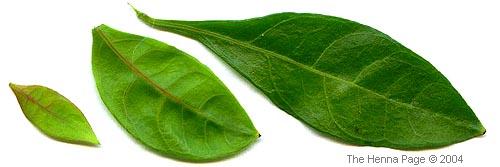 High lawsone in petiole of younger leaves
at left
Actual size of largest leaf 4 cm Henna will only grow where minimum temperatures stay above 50 degrees fahrenheit or 11 celsius. It will tolerate extreme heat and long droughts. It grows wild near desert oasis, and in semi-aid regions. It thrives in alluvial soils, where there is annual precipitation of 0.2 to 4.2 meters and a soil pH of 4.3 to 8.0 (4.1-31). Its growth range is detailed in the map at "The Geography of Henna" . In ideal conditions, such as detailed in "Henna Farming in Pakistan", and "Where is henna grown, processed and exported in India?" , the plant is cultivated for body art quality henna. In slightly less than ideal conditions, it is cultivated for hair quality henna. In cooler, more moist conditions, it is cultivated as a flowering hedgerow shrub. It can be grown as a houseplant in cooler climates. The flowers are fragrant, and may be white, red, pink or yellow. The four-petaled flowers grow in a branching clusters like a cluster of lilac blossoms. For more information on henna flowers, go HERE or click on the image below: In the southern and western Mediterranean countries, henna flowers bloom in April and May. The henna fruits ripen at the end of the summer. In each henna fruit there is an average of 40 - 45 seeds. 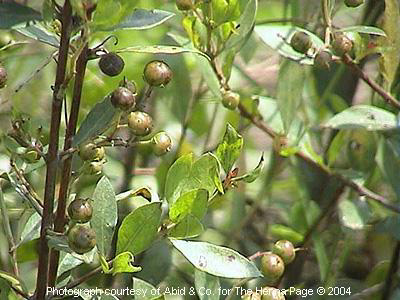 Henna seeds are very small and polygonal. 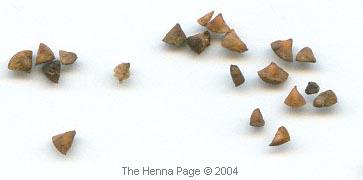 Henna Seeds: actual size of seed is 1 - 2 mm The
plant can be propagated by rooting the cuttings, or sewing seeds.
For more information on sprouting seeds, go HERE: Germinating Seeds by Mark Foster
.Click HERE to investigate henna flower perfumes Return to the Index of Henna: Lawsonia Inermis References: Abid & Company (Pvt) Ltd. Lahore, Pakistan: Jamila Henna Bakshi, G Flora of the Murshidabad District, West Gengal Scientific Publishers, Jodhpur, India, 1984 Hepper, N., and Friis, I. Field, H. Body Marking in Southwestern Asia Peabody Museum of Archaeology and Ethnology, Harvard University, 1958 Hepper, N., and Friis, I. The Plants of Pehr Forsskal's "Flora Ageyptiaco-Arabica" Royal Botanic Gardens, Kew, in association with the Botanical Museum, Copenhagen In the Temple of Solomon and the Tomb of Caiaphas Biblical Archaeology Society 1993 The Perfume Industry of Mycenaean Pylos Paul Astroms Forlag, Goteborg, 1985 Zecharia Douri Eshkol ha Kofer Israel Can't find what you're looking for? Try: The Henna Page Main Index http://www.hennapage.com/henna/mainindex.html the Encyclopedia of Henna Catherine Cartwright-Jones c 2000 registered with the US Library of Congress TXu 952-968 |
